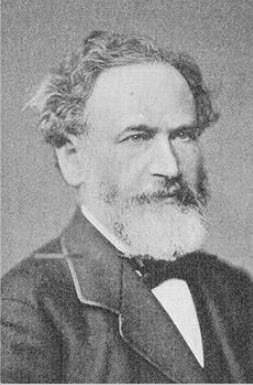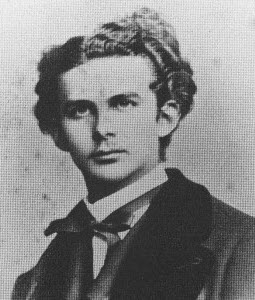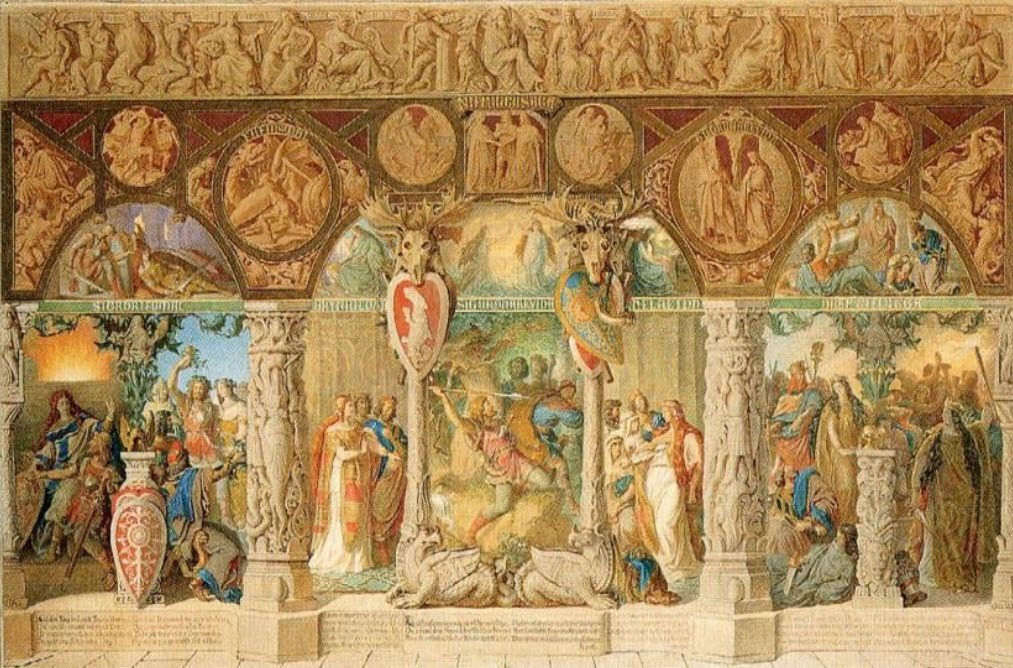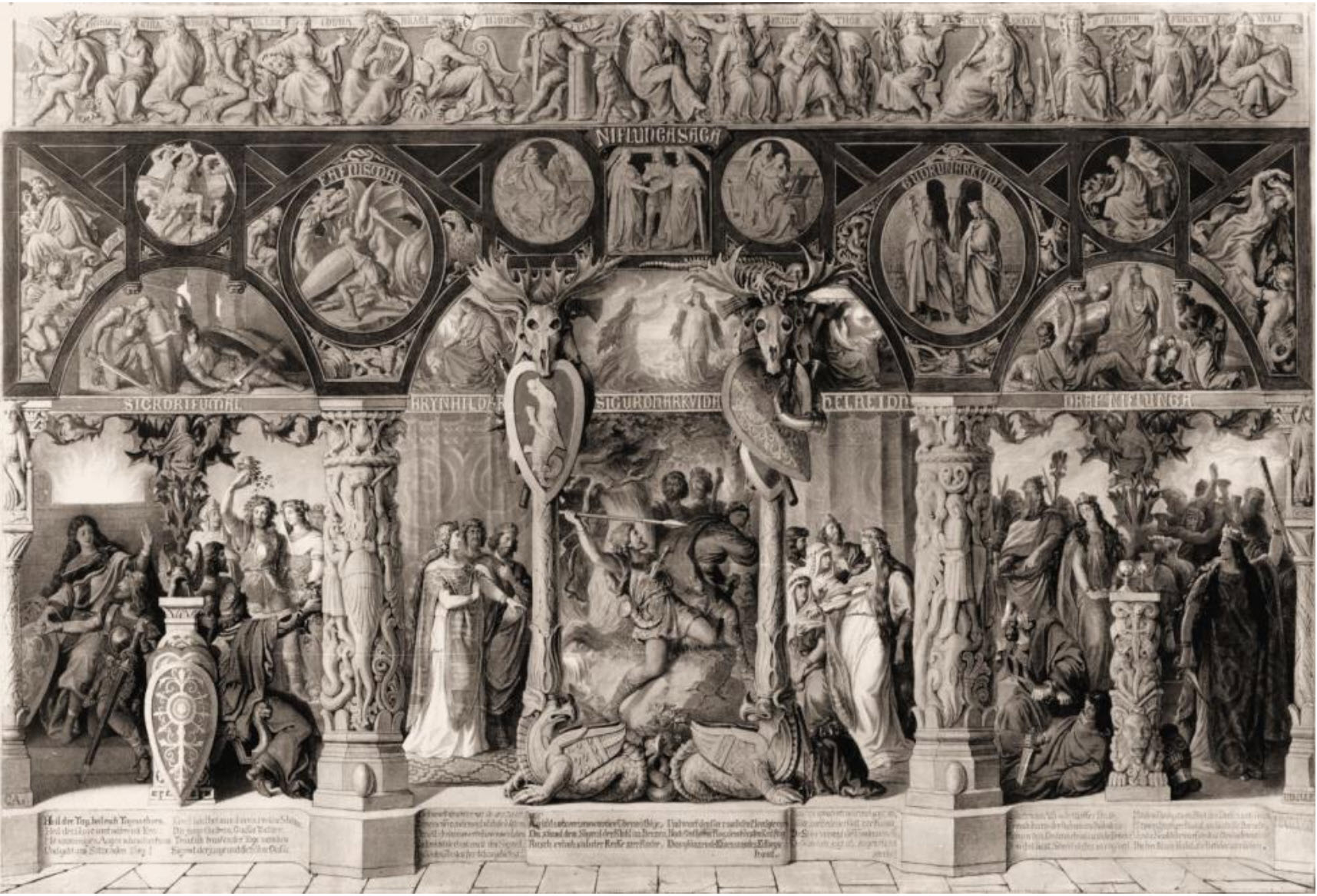|
. |
| |
|
|
Eduard Ille (June 17
1823—Decemeber 17, 1900) was a painter, illustrator and
poet, who lived in Munich all his life. After graduating from high school, he
studied at the Academy of Fine Arts in Munich under
Julius Schnorr von Carolsfeld and Moritz von Schwind.
After trying unsuccessfully to work in the field of
religious painting, he turned to illustration in the
1850s. During this time, he provided drawings for
woodcuts for L. Bechstein's Deutsches Sagenbuch 1853, M.
Schleich's Punsch and J. J. Weber's "Illustrirte
Zeitung". Through his work on "Hauschronik", he
was gradually drawn into full-time employment at the Munich magazines
Münchener
Bilderbogen and
Fliegende Blätter (Flying Leaves), the latter of
which he became co-editor in 1863 and played a large
part its extraordinary success with his fresh and
imaginative stylized caricatures. In addition, Ille also
produced an independent series of woodcuts: The seven
deadly sins, a series of 8 drawings cut in wood, 1861;
Lamport's living picture book with moving figures, 1863;
Little Red Riding Hood, composed in 6 pictures, 1872;
Grimm's Kinder- und Hausmärchen in pictures, as
well as illustrations for other works. In 1868 the Munich Academy honored
him with the title professor.
 |
 |
| Eduard
Ille |
King
Ludwig II |
During his life, Ille executed several
important works of art commissioned by the Bavarian King
Ludwig II. His murals at Schloß Berg include Lohengrin
1865, Tannhäuser 1865, Niflunga Saga 1867, and Parsifal
1869. An oil painting titled Die Meistersinger von
Nürnberg (1866) also formerly hung there. Ille also
executed murals in the King's dressing room at the
Neuschwanstein Castle from the life of Walter von die
Vogelweide and Hans Sachs. He also wrote some dramas and
opera texts, as well as numerous occasional poems and
verses for the "Flying Leaves" and for series he drew.
His extensive art collection and a valuable collection
of his own drawings were auctioned off in 1901 at
Mössel, Berlin.
|
|
Translated from portions of Gunter
E. Grimm's "Niflunga-Saga.
Zu einem Gemälde von Eduard Ille"
(2015), Paul Hermanowski's
Die Deutsche Götterlehre und ihre Verwertung in Kunst
und Dichtung (1891),
pp. 193ff,
Allgemeines Lexikon der bildenden Künstler von der
Antike bis der Gegenwart (1925) and a
contemporary newspaper account (Dec 25, 1867) |
|
|
|
The Tempera Painting "Niflunga-Saga" by Eduard
Ille, 1867. |
A relief-like frieze of an assembly of the Old
Norse gods is found over the entire large sheet of
21 images in total.
(Heimdall, Eir, Vidar, Uller, Iduna, Bragi, Njord, and
Tyr are seated to the left of Odin, enthroned at the
center; while Frigga, Thor, Freyr, Freyja, Baldur,
Forseti and Vali are seated to the right of Odin.
|
 |
|
Detail of the Frieze of Old Norse
Gods, left (above) and right (below) of Odin. |
 |
|
|
 |
|
|
Eduard Ille's Niflunga-Saga as described
by Paul Hermanowski (1891):
|
"For the painter who desires to depict the
"Niflungen saga"
as Eduard Ille does for King Ludwig in watercolor, it
is not inappropriate to
first present the Aesir and Aesir. Up
in the top middle, we find Odin seated on his
throne, grasping his spear
upright in both hands. A thick, wispy beard
frames his face. One does not notice that he is
missing an eye. A helmet-like cap covers his head. A
long cloak envelops his figure. On either side are
the wolves at his feet and the ravens on the
armrests of the seat.
There now follow to his right, Frigg with a distaff
and spindle in her hands, and to his left, Thor,
dressed in battle garb, gripping in his iron-clad
fists the mighty club-like hammer, the handle of
which is long rather than short. A helmet adorns his
head. He also buckled on the power belt. Behind him
are his two long-horned bucks in front of the
two-wheeled chariot.
Now come Freyr and Freyja. Both are wreathed and
dressed in long robes. Freyr has a sheaf of corn in
his right hand and a bowl of fruit in his left. A
sickle hangs from his belt. Freyja has a torch in
her right hand. A precious jewel adorns her neck and
breast, and a cat sits on her
left side.
This is followed by Baldur, the judge's staff in his
right hand, his head surrounded by a halo, also in a
long cloak-like robe. Beside him sits Forseti, his
son, raising the index finger of his right hand and
holding in his left arm a magistrate and a tablet of
the law.
The last picture on the right shows Vali armed as a
warrior. His left hand rests on a powerful round
shield, with his right he holds a bow. On the ground
lies a quiver with arrows.
As on the right, deities are all seated on Odin's
left. There we first see the battle god Tyr. A helm
tipped with mighty eagle wings covers its head. He
rests his chin on the hilt of the mighty sword,
which he grips in his right hand. On the edge of his
large rectangular shield he has placed the stump of
his left arm.
To the left, in front of him sits Njördr, with a
trident, the reed-crowned hair and the dolphin under
his right foot marks him as a sea god. His torso is bare.
Then Bragi and Idun follow. A wreath adorns Bragi's
rich, curly hair. His beard is full. A wide cloak
envelops him. With both hands he grips the strings
of the harp, which is on his knees.
Next to this old man sits the youthful Idun, handing
him an apple with her left hand, while holding the
bowl filled with apples with her right.
Uller now follows, dressed in a fur coat and hat. He
has his bow over his left shoulder and the quiver
with arrows on it hangs on his back. He has already
strapped his ice skate under his right foot, he is
just about to stop the left foot from getting one
too. A hound looks up at its master for prey.
Then comes the silent but strong Vidar. He put his
finger to his mouth as a sign of silence.
After him we see Eir, the goddess of Ieechcraft. She
holds a healing herb in her right arm.
Health-bringing plants are also at their feet. There
is a bowl on the left knee. With both hands she
holds a rune tablet in the right one.
Heimdall forms the end of the left-hand side or the
beginning of the entire upper frieze. From its perch
on a bridge-like ledge, the rainbow arches. A
ruffled robe covers his torso. Listening sharply, he
peers out into the distance. He has his sickle-like
horn in front of him on his right knee. He seems to
want to put it near his mouth; for the giants may
already be approaching."
|
 |
The individual songs of the Edda are
implemented scenically on the middle level of the picture. In the
center is the title of the painting "Niflunga Saga",
then in two medallions, the two Eddic songs "Fafnismal"
and "Gudrunarkvida." The pictorial scenes are garnished
with all kinds of elements of the Bavarian
Berghütten-romantic style with its Alpine charm.
Above, two bare elk skulls, garnished with a sword-axe
and morning star, grin down. Below, two griffin-headed
dragons support scultured pillars on which two fantasy
coats of arms are hung.
The reverence that Ille shows his king here is unmistakable: Ludwig II was
the owner of eleven hunting lodges and Berghütten
(mountian-lodges). Louis' declared model was the
French "Sun King" Louis XIV. Hence the choice of the
Norman shield type —round at the top and tapering
at the bottom — and three golden lilies on a blue
background, the floral emblem of the House of Bourbon.
The rose in the middle of the shield could be
reminiscent of the "Geldern rose", a medlar flower. The
Geldern coat of arms is based on the 878 AD legend of
Wichard and Lupold von Pont's fight with a dragon. The
second coat of arms, with its red base color, could be
reminiscent of the coat of arms of the English king
Richard III. But since any legendary or historical
connection is lacking, it is more likely a fantasy coat
of arms.
The names of Eddic songs appear in gold letters on a
green background. The names "Sigrdrifumal",
"Brynhildar", "Helreidh" (Brunhilde's Hel-Ride), and
"Drap Niflunga" (Murder of the Niflunge) refer to the
images in the semi-circular arches, in addition the
names of the characters depicted in the scenes are
written in the manner of a schoolmaster. In the center
is the scene with the murder of Sigurd. As is well
known, Hagen killed Siegfried, who was kneeling at the
spring, by throwing a spear from behind.
|
|
|
|
THE MAKING OF A MASTERPIECE |
|
Eduard Ille is best known for a series of paintings
based on medieval legends. He first came
into contact with the Nibelungen legend as a student
of Julius Schnorr von Carolsfeld, who became
famous for his Nibelung frescoes in
the Munich Residence (the former royal palace of the
Wittelsbach monarchs of Baveria), which he painted between 1827
and 1867. During this time, Schnorr was a professor
at the Munich Art Academy. In 1846 he left Munich
and went to the Dresden Art Academy.
Ille's own interest in the Nibelung legend came
about 20 years ago later, in 1865, when his
unfinished painting "The Song of the noble knight
Tannhäuser" aroused the interest of the Bavarian King
Ludwig II, a lover of art. The king liked the work
so much that he instructed Ille to complete the picture
immediately, and commissioned pictures of Lohengrin and
Hans Sachs. The pictures still hang in the living room
and study of Berg Castle on Lake Starnberg, which is
privately owned by the Wittelsbach family. Ille's estate
is located in the Munich literary archive Monacensia and
consists of sketches, seals and 55 volumes of diaries
and appointment calendars, that Ille composed between
1842 and his death in 1900, containing meticulous
accounts of his daily life. This diary is a primary source for information about Ille's day-to-day work and
about artistic life in the residential city of Munich at
the time.
At the beginning of March 1866, Ille was promised an
audience with the king. But in mid-March the royal
adjutant informed him that the king was so overwhelmed
with political business that he could not receive the
painter, but after the completion of the new
picture of Hans Sachs, the king might take the
opportunity and have the pleasure of getting to know
him. Ille found the cancellation of the royal audience
humiliating, mainly because it had been delivered by a
domestic. However, in mid-December, Ille reported that
the court secretary Lorenz von Düfflipp conveyed the
king's "great satisfaction" with the Hans Sachs painting
and gave him the order to "paint a picture, in the
manner of the 3 previous paintings, of the old Nibelung
legend from Norse mythology". Ille's reaction was
"half happy and half grieved". Over the next few days,
he read up on the Nibelungenlied and its relationship to
the Nordic version in Hyacinth Holland's flowery
“History of German Literature”, published in 1853. He
learned that the original version of the epic has been
lost, but that the Poetic Edda has "the basic plan
sketched out here and there", which he characterized as
"very brittle, heavy and tough material". There is an
undated eight page sketch within Ille's records titled
"Das Nibelungen-Lied", in which Ille describes his
research and presents his assessement of the
Nibelungenlied: “As a national epic, it rightly claims a
very excellent rank and remains, as Franz Horn puts it,
'an eternal pillar around which brave Germans like to
gather'." The reference here is to Franz Christoph
Horn's book The Poetry and Eloquence of the Germans from
Luther's Time to the Present. The sketch shows that Ille
was well acquainted with the German version of the
legend. The royal commission, however, was about the
representation of the Nordic variant. Richard Wagner's
"Ring" tetralogy, based on Nordic myth, was likely
tacitly behind the royal request. In January 1867, Ille
read the relevant sources of Nordic mythology.
All the while Ille kept company with
Harbni-Gesellschaft, a Munich association of
culture-loving and charitable people founded in 1850.
Their playful rituals were reminiscent of the baroque
language societies: all members of the association,
posing as a knightly order, assumed knight names; Ille's
nickname was Eduard Wörgl von Brixlegg. His Hans Sachs
picture was duly honored in thier circle. Incidentally,
he learned that the king had spoken of him and his art
in a "completely exalted" manner. The Court secretary
Düfflipp informed him again that the king was extremely
satisfied and has the intention of speaking to him; an
audience had been reserved for the next few days. This
time, however, Ille was skeptical. In a diary entry on
March 7th, he wrote: "I want to see if the king really
receives me this time! I'd love it, but I won't believe
it until I'm there.” He remained in anticipation at
home, but had to note: "No king's call rang out to me".
And a day later he thinks he knows why: the king's bride
Princess Sophie was reported to be ill, "which is
probably why he doesn't see me". However, this may be a
false conclusion, since the extremely shy Ludwig often
avoided contact with strangers and put forward all sorts
of excuses. While Ille continued to work on a painting
of the Thirty Years' War, he further deepened his study
into the Nibelungen material, reading Wilhelm Grimm's
heroic songs, Karl Simrock's translation of the Edda,
and excerpts from the sources with the still hopeful
thought "that I am well in the saddle if the king
calls.”
|
|
The Berg Palace— Berg Schloss, circa 1886 |
|
At the end of March, Ille examined the illustrations
Ludwig Schwanthaler created for the northern gable group
of Walhalla completed in 1842 - as a model for his
picture of the Niflunga Saga. His work on the Sigurd
painting began in May. Ille was then busy with the study
of Norse weapons to create an authentic atmosphere. In
September he came to the main picture of the complex,
the assassination of Sigurd, which he painted early in
the morning “with seriousness and zeal”. In October a
cabinet servant inquired when the king could get a
photograph of the picture – which upset the artist
greatly. In this respect, the information sent by Hofrat
Düfflipp News that the king was satisfied with the
photographs, certainly had a reassuring effect. His
friend Hyacinth Holland also looked at his picture “very
approvingly”. On December 3, Ille noted in his diary
that he celebrated the "completion of my picture".
35 official photographs of the
"Niflunga"-picture were made. On December 18, a
great sigh of relief was felt in his beloved Harbni
Club, as his friends congratulated him on his new
picture cycle. The year of completion is found at the bottom
right of the picture next to the Artist's signet: 1867.
After Ille had created the final image in the series of
legends, the "Parzival" painting, the king wished the
painter to depict the life of Louis XIV of France. But
Ille refused - in all deference, because he was
reluctant to paint the destruction of Heidelberg and the
devastation of the Palatinate by the French General
Mélac. He even accepted the king's disfavor for this.
But the king was apparently on Ille's reaction prepared.
He told Leinfelder that he was not ungracious, as Ille
had feared, "because" - literally - "he could have
expected something like that from Ille's stubborn head".
Nevertheless, he does not seem to have forgotten Ille's
refusal, because the next royal commission came five
years later. Now, with unmistakable irony, the king
asked the artist whether he would now be “so gracious”
as to decorate the dressing room in Neuschwanstein “with
pictures from poems by Walther von der Vogelweide”. Ille
was certainly happy, but this joy was somewhat clouded
by the king's impatience. In the autumn of 1880, the
king sent a letter via the court secretary to all the
painters involved in painting the palace, informing them
that “his Majesty would arrive at 12 o'clock on Christmas Day" to
Neuschwanstein. By then, all pictures should be finished.
So Ille needed the help of a painter friend to implement
the color sketches.
The literary historian Hyacinth Holland, who survived his friend Ille by
15 years, in his obituary, characterized the style of
the Niflunga-picture cycle, emphasizing the
"architectural framework strictly adapted to the
respective subjects and times" and the "continuous,
highly attractive juxtaposition within the pictorial
narrative". It surpasses the other picture-cycles in
terms of the number of scenes. "Tannhäuser" offers 5,
"Lohengrin" 11, "Hans Sachs" 9, and "Parzival" 19
individual scenes, while the Niflunga-picture groups 21
individual scenes in a multi-subdivided, columned hall.
The structure of the picture is strictly symmetrical. It
consists of three levels, a frieze, a middle level and a
lower level with large painted scenes on a base. The
emblem tradition emerges: the inscriptio in the middle
of the picture, the picturae on three levels, the
subscriptio at the bottom edge of the picture, and in
the names distributed across the picture. The text
embedded in the base explains the seven scenes above it,
shown on the lower level, with quotations from Simrock's
translation of the Edda. The frieze is
demonstrably based on Ludwig Schwanthaler's Walhalla
Frieze as the most important marble gable group since
antiquity, as Albert Müller 1865 in his monograph on
Walhalla states. The theme of the Walhalla frieze was
the Teutoburg Battle. With Schwanthaler, Arminius is the
central figure, with Ille, Odin, the father of the gods.
Oddly enough, he and the others depict Nordic gods in
ancient robes in classical fashion. "Niflunga-Saga" is
not a watercolor, as often stated, but a tempera
painting, using a technique in which paint pigments are
bound with a water-oil emulsion. A big advantage of
Tempura is its resistance to aging and its slow drying
that allows for longer rework.
|
|
|
|